Mauricio Pochettino is the latest coach at Spurs and we will be seeing a different philosophy and playing style this season.
If you’ve missed any posts, you can catch up on the overview of Mauricio Pochettino’s system here. What it will mean for our goalkeepers, what changes our defence will need to make and how will it affect the midfield by clicking the links.
In the final part, we’ll be taking a deeper at look at what will be required from our forward players.
Mauricio Pochettino has three formation sets that involve the forward players. The first is a lone striker in 4-2-3-1; the second is an additional striker operating in the number ten position, but also in the 4-2-3-1 formation. The third is a trio of forwards in a 4-3-3 system.
Lone striker 4-2-3-1
This is Mauricio Pochettino’s most common set-up whereby he utilises a number nine who is capable of playing as a lone striker.
This player has a number of roles in the team:
– Work the channels
– Hold the ball up
– Release valve for any long balls cleared from defenders under pressure
– Come short to take vertical passes out of defence and hit runners going past him
Mauricio Pochettino had both Rickie Lambert and Dani Osvaldo for this role at Southampton, usually opting for the now Liverpool man.
Lambert could be forgiven for being thought of as a typically big, aerially strong English number nine. However, Mauricio Pochettino used him to take advantage of his excellent movement and range of passing.
Lambert was not quick over the ground, but he didn’t need to be, as his intelligent moves dragged defenders out and he was able to find faster players running past in to the space.
A great example is here, where he comes short to get on the ball in midfield trapping Hull defender Paul McShane in two minds as to whether to go or stay. This leaves him in no man’s land and allows Adam Lallana to race in to the space behind. Lambert puts him in on goal with a perfectly weighted through ball.
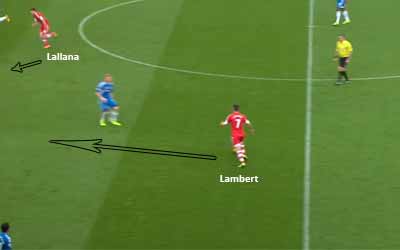
Lambert in the above image is in the inside left channel, but his ability to work the channels on each side of the pitch can be seen from his passes received in the match. Note how he rarely receives the ball in the middle of the pitch until up in the final third. This is the sign of a good striker, one who moves away from central defenders, giving them a choice to make of whether to track him.

Lambert not only receives the ball from longer passes delivered from the goalkeeper and defenders, but is also heavily involved in the middle third. Up top, he is tasked with getting on the end of crosses, where he likes to pull on to the full backs in order to use his size and out jump them. Whether this is just a Lambert trait of trying to match up on a smaller full back or something Mauricio Pochettino coaches, we’ll have to wait and see.
If we look at another game, Southampton’s Premier League match with Fulham, we can see a lot of similar things going on.
Lambert is a release valve for anything sent forward long from the back (this can be in the air or to feet). He comes deep in to midfield and works both sides of the pitch, only appearing in the centre in the final third to get on the end of crosses.
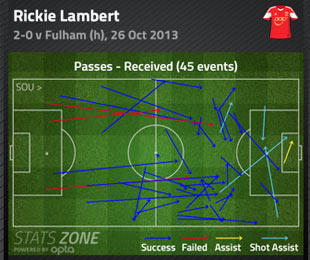
His passes in the game see him try to hit those who have moved past him, especially through the inside right channel of the penalty area.
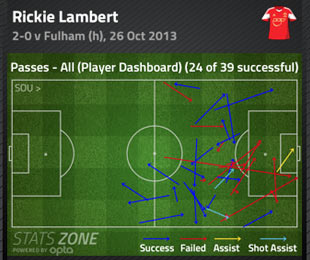
This is what Mauricio Pochettino is looking for from Rickie Lambert, so that he can take advantage of his excellent range and touch on passes.
We saw some similarities with this in our pre-season game with Toronto.
Roberto Soldado came short and fed in Erik Lamela as the Argentinean surged past him for our first goal, with the aid of Lennon stepping over the pass.
Note how Eriksen and Lennon ahead of Soldado are occupying the defenders and the spare centre back is caught in two minds and several yards off Soldado.
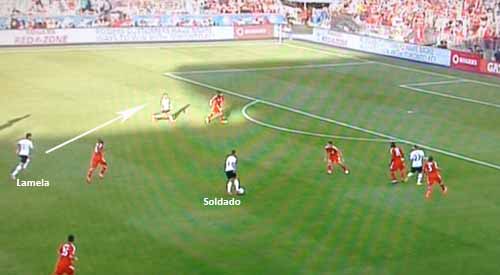
He then set-up Lamela once more with another perfectly weighted ball as the Argentinean flew past again in to the space to get his second. Eriksen and Lennon were once again looking to move past Soldado from their roles in the advanced midfield three.
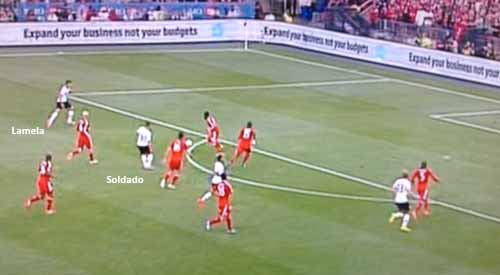
4-2-3-1 second striker
I talked about this approach in the post yesterday about how Mauricio Pochettino will change our midfield, so I won’t spend too much time on it again.
Rather than play a more traditional number ten in Adam Lallana, Pochettino will go for another striker, but in the hole. Usually this was Dani Osvaldo, but after his fall out, Jay Rodriguez often popped up here.
This of course means that you lose the traditional passing lock-picker (Lallana) from the number ten slot. However, in this set-up, he is often moved out to the right to drift inside from wide.
What is gained in this formtation is another man to get in the box for Southampton’s crossing. With Jay Rodriguez cutting in to the penalty area from the left and Osvaldo joining Lambert from the number ten position, there are at least three targets. They were often joined by the late arriving box-to-box midfielder (Schneiderlin) to get another body in the penalty area.
Mauricio Pochettino often used this system to overpower supposedly weaker teams that may sit back.
4-3-3
The three forward formation is one that Mauricio Pochettino switched to quite regularly and works like this.

In this set-up he would often move his wide midfielder (Steven Davis) from the 4-2-3-1 set-up in to the centre to become more of a creative passer. Alongside Davis he would sit a box-to-box midfielder (Schneiderlin) with a defensive midfielder (Wanyama).
The three forward positions would see a wide forward in Jay Rodriguez out on the left, moving towards the middle in the final third.
Rickie Lambert as a number nine, working both sides of the formation and coming short so that runners could work off him.
The change would come out on the right, where Adam Lallana would become a drifting playmaker. The key is the positions that Lallana takes up as he moves across the formation.
From Lallana’s passes received map, we can see how he drifted across the pitch from his role on the right of a front three.

He often changed positions with Lambert and Rodriguez to highlight the fluid nature of Pochettino’s formation, which is at its most prevalent in this set-up.
This movement allows Lallana to play through balls or shorter pulled-back crosses when he is in the penalty area.

He can also burst past his centre forward, as he did on scoring Southampton’s second goal, after moving inside from the right.
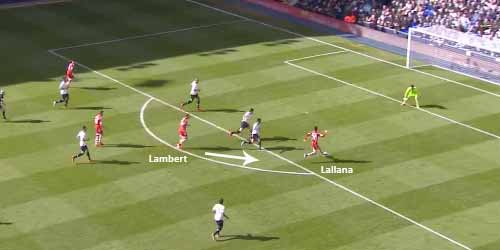
This is not just limited to having Adam Lallana and getting arguably Southampton’s best player in to this formation. When Mauricio Pochettino went 4-3-3 with the Saints, he installed a drifting playmaker from the right.
At home to Norwich, Gaston Ramirez filled this role with similar results, as Saints ran out 4-2 winners.

Christian Eriksen may well get the nod to fill this role for us this season. Interestingly he started from the right in a 4-2-3-1 in the pre-season friendly against Toronto.
This may draw some comparisons from last season where he drifted from a left midfield position. However, unlike then when his drifting would leave his full back exposed, especially when we were 4-4-2, he will now have the cover of an additional midfielder (the Steven Davis’ role) in the 4-3-3 set-up.
How Mauricio Pochettino will change Spurs
In this series i’ve looked at an overview of Mauricio Pochettino’s system. What it will mean for our goalkeepers, what changes our defence will need to make and how will it affect the midfield and our forward line. Thanks for reading.
Next week I’ll be taking a look at two of our new signings, Ben Davies and Michel Vorm, so look for the article links on Twitter or Facebook.

Southampton were good last year but they still were beaten twice by Spurs and finish in eight place. Are their players a little overrated and what were their weak points.
AVB setup was quite similar to southampton at the start of the season. I think the High line defence has been ripped apart by good teams and it must be close to the end for that tactic in mordern soccer.
In spurs case, teams let us press them but stayed very compact in defence when it broke down. They patiently waited for the counter attack using the space behind the high line hammer (west ham) home some easy goals against a defence in disarray. Often only two or three players needed to be committed to these cointer attacks.
In our case, the high-line worked quite well – thanks, in part to having the perfect sweeper-keeper to play it.
Where it fell apart, it was usually down to the personnel employed more than the tactic itself, and the management decisions involving those personnel.
To take the most obvious case – Tottenham 0 Liverpool 5, the game that proved to be AVB’s last: Defenders need to be quick to play the high-line, we had Walker, which was fine. We then had, for centre-halves, Dawson, who is the least suitable defender to play a high line on the whole planet, and Capoue, a central midfielder recovering from injury and who, so far as we know, was unfamiliar with playing a high line when he had been called on to play in defence in France – and not particularly blessed with pace. And we had Danny Rose, a left-back who AVB had so little faith in that he often drafted in Kyle Naughton, a right-back, in his place. AVB could have played Fryers, but, having said that Rose and Fryers was acceptable as options at left-back, he then refused point-blank to play Fryers, and found Rose so inept on the day that he replaced him with Naughton. And it needs to be said that AVB wanted to sell Dawson as soon as he arrived. He allowed himself to be talked out of it, and stuck by that into his second season – these were his decisions, and no-one else’s. IMHO, the decision to keep Dawson, when Kaboul was so doubtful due to long term injury, Chiriches was a newbie, with all that entails, and Vertonghen was being played on the left, in place of Rose, half the time, was probably the biggest blunder AVB made. It meant that for a manager who insists, full stop, in playing a high-line, was often stuck with a player singularly unqualified to play a high-line, as his experienced centre-half.
On that day, we were left with Walker as the only player really suited to playing a high-line that the head-coach had any confidence in, at all. And this was against the team most suited to taking advantage of any weaknesses in a high-line defence. AVB could have suggested that the defence drop the line a bit deeper. But he didn’t. He could have insisted Dawson go and another Defender properly suited to playing a high-line come in. But he didn’t. He could have either insisted Rose either be replaced or he be provided with proper competition for him. But he didn’t. And he could have been less obstinate and modified his tactics to cater for the fact that he didn’t really have defenders suited to playing it and was against a team who were ideally suited to taking advantage of that. But he didn’t.
The high-line served us well enough to get 69 points while having a farcical season. Southampton had inferior players to us, on the whole, and a weaker squad – but attained their best EPL finish, playing a high-line.
If you read the article on defenders you may have noticed Mark – I can call you mark, can’t I :) – state that occasionally the tactics will break down and lead to a goal. But Pottechino will accept that, as long as the balance is in favour of continuing with the tactic. And that, really, is what it is all about…percentages! No system is entirely fool-proof. There has never been a title team that has never conceded a goal. If the high-line helps you to dominate teams, score more goals and win more games than alternatives, then the balance is in its favour – even if it leads to the occasional clanger, and even the occasional defeat. If Pochettino favours playing a high-line for this reason, maybe we should all just wait and see how it works in effect, rather than judging him by a theoretical dislike of it, or the imperfect implementation of his predecessor.
COYS
Good comment SP and yes you can call me Mark :) Agree about tactics playing percentages and therefore managers will live with the consequences or a bad result if it means that they win more than they lose.
Re the high line, Manuel Neuer was one of the stars of the World Cup, more for his ability to clear up danger behind his defence than actually pulling off world class saves.
I have to disagree with you Mdowd in that i don’t think the high line is dead at all, didn’t Germany just win a World Cup by playing it?
Teams did sit deep against AVB’s Spurs, but they knew that we weren’t quick enough to transfer the ball forward and our attacking build-up was lethargic. That’s what will be different under Pochettino, there is much more vertical passing in his system. He also often plays with the second striker as a number ten option against teams that sit back.
All good teams have to put up with opponents that park the bus though, so it’s a problem you have to solve.
As Mark says, all good teams face oppos that shut-up and look to nick a goal on the break.
I don’t want to sound anti-Redknapp, as he gave us some great days (and nights), but folk are looking at things through rose-tinted glasses if they can’t remember that this exact thing happened to us under him. And when it did, even with Modric, VDV and Bale in the team, we were often turgid and seemingly devoid of ideas (other than to hope for a worldie from someone).
I would have to agree with Mark (again): the problem with AVB’s set-up wasn’t the high-line, as such, it was the lack of urgency in transition. I watched quite a bit of the Saints last season – proud to say I predicted a good season for them :) Where AVB’s Spurs team looked like they were happy to take an eternity to bludgeon teams into submission with one goal, so long as we didn’t concede, Southampton, under Poch, seemed to be going at teams in waves. And once they got their goal and the other team pushed for an equaliser, they looked even more lethal counter-attacking. I often felt that with a little bit of quality they would have won far more (Chelsea, at SB, springs to mind). Well, surely, overall, as a squad, we have more quality than Southampton.
Great comments so far, btw.
In my opinion, when we did so well under Redknapp, it was partly because teams kinda still thought they could go toe-to-toe with us. They looked at us, mid-table Spurs, they looked at bloody 4-4-2 Harry, and they thought, there may be 3 points in this.
After a few seasons of us getting 4th/5th, they stopped thinking this and you saw a lot more bus parking at the Lane. Now at this point, I think you need to have a tactical plan to break teams down. You _really_ need it when you lose those rare players who can create goals in tight situations (Modric, VdV) or goals out of nothing (Bale in his last 1/2 season).
Yeah, that’s pretty much how I see it.
I think the idea, after it became evident that ‘Arry couldn’t break ‘bus-parkers’ down, was to go for a more measured, analytical approach promised by AVB. Unfortunately, the promise was greater than the reality. We can only hope that Pochy’s greater emphasis on quick transition, higher tempo and forward movement doesn’t get bogged down in the same quagmire. Hopefully, having seen his formation in operation at Southampton, and something of it in the States, we might just get that now!
Completely agree Chris. Teams parking the bus is something all managers have to solve, especially in-game as well if things are not going to the original plan. A manager has to be flexible.
Great series of articles, Spursfanatic, but like Mdowd I’d like to know what Poch’s plan B will be when a team parks the bus with a 4-4-2 and plays the counter attack gambit.
I suggest the defensive midfielder will need to play deep against such teams, and strong practice of the set-plays will be important.
Thanks for reading Mike. I think Pochettino’s plan B will be the second striker as a number ten. He might also ditch the defensive midfielder for more of hybrid player that can move the ball forward and defend, such as Dembele against the Bus parkers.
Brilliant read this series. So based on what you have analysed, and out of the players we currently have, what will be our strongest 11? Would Soldado suit the lone striker role better than Ade? Can Holtby find his way in somehow? Who is better suited to the DM role, Sandro or Capoue? Personally:
Lloris
Walker, Criches, Vertonghen, Davies
Capoue, Holtby
Lennon (although I would try someone else) Eriksen, Lamela
Soldado.
Great question NorthernSpur, my team would vary depending on the level of the opposition. ie One change i would make against weaker opponents would be to bring in Holtby for Paulinho, but if everyone is available, my base 11 against a decent side would be this:
Lloris
Walker, Chirches, Vertonghen, Davies.
Capoue, Paulinho.
Lamela, Eriksen, Chadli.
Soldado
Thanks for great article Mark. I just finished translating your series including this article.
At some point, I was wondering about Sam Gallagher. The young forward at Soton. I think he was in the match quite often.
What can you say about him? What’s his type and how did Pochettino used him in his set-up?
Thanks for translating Soulchan, you must have been busy! ;)
I think Sam Gallacher has potential and we really need to remember he is just 18 years old. For his size (194cms) he needs to bulk up a bit as he was often getting knocked off the ball or out-muscled. He doesn’t win as much in the air as he should do for his size, but that might come with time. He also doesn’t pass the ball as well as he could do. He reminds me more of Peter Crouch than a Rickie Lambert.
Pochettino mainly used him up top as a number nine, but often with either Lambert or Osvaldo playing as a support striker from a number ten position behind him. I think this says much about where maybe Gallacher is at in his career, in that he could be thought of as a finisher but not a player that is going to hold up the ball or create much at the minute. Decent prospect but i wouldn’t be making a move for him just yet.
Great series Mark….as usual fantastic stuff…
I think our squad will be done if we acquire a new CB while shipping out dawson…
so, there goes the question….whom you will buy to partner Jan Vert if you are given the option?
Thanks Naresh and good to see you back on the blog.
Good question. There are a number of defenders i would sign if money and them moving was no problem. I think for us though there are transfer fee and wage restrictions (as was shown with us not going for Lovren who went for an obscene £20 million). I also think this transfer window we are restricting ourselves to players with Premier League experience after bringing in so many foreign faces last summer. On top of that, age seems to be a factor with most of our signings being under 25/26 so they have sell on value.
With the above in mind, this explains our links with John Stones from Everton. For me, I quite like our own Milos Veljkovic, but he is probably a season or two away from being ready for the first team. Otherwise i’d look to go after Winston Reid.